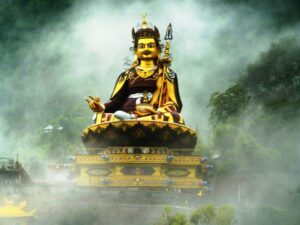 Divine Incarnations (in any religion) may take further incarnations or manifestations. Padmasambhava – who incarnated as a fully enlightened being – was foretold by Buddha Shakyamuni. Padmasambhava is considered the Second Buddha by the Nyingma school, the oldest Buddhist school in Tibet known as “the ancient ones”. Padmasambhava also established the Nyingma School in Bhutan. The purpose of multiple incarnations of a deity is divine revelation: the devotee must be exposed to different dimensions of the divine diamond.
Divine Incarnations (in any religion) may take further incarnations or manifestations. Padmasambhava – who incarnated as a fully enlightened being – was foretold by Buddha Shakyamuni. Padmasambhava is considered the Second Buddha by the Nyingma school, the oldest Buddhist school in Tibet known as “the ancient ones”. Padmasambhava also established the Nyingma School in Bhutan. The purpose of multiple incarnations of a deity is divine revelation: the devotee must be exposed to different dimensions of the divine diamond.
When Guru Padmasambhava appeared on earth, he came as a human being. In order to dissolve our attachment to dualistic conceptions and destroy complex neurotic fixations, he also exhibited some extraordinary manifestations.
In accord, Rigpa Shedra also states the eight principal forms were assumed by Guru Rinpoche at different points in his life. Padmasambhava’s eight manifestations, or forms (Tib. Guru Tsen Gye), represent different aspects of his being as needed, such as wrathful or peaceful for example.
The Eight Manifestations of Padmasambhava belong to the tradition of Terma, the Revealed Treasures and are described and enumerated as follows:
Guru Pema Gyalpo of Oddiyana, meaning “Lotus King”, king of the Tripitaka (the Three Collections of Scripture), manifests as a child four years after the Mahaparinirvana of Buddha Shakyamuni, as predicted by the Buddha. He is shown with a redish pink complexion and semi-wrathful, seated on a lotus and wearing yellow-orange robes, a small damaru in his right hand and a mirror and hook in his left hand, with a top-knot wrapped in white and streaming with red silk.
Guru Nyima Ozer meaning “Ray of Sun”, the Sunray Yogi, semi-wrathful, manifests in India simultaneously with Guru Pema Gyalpo, often portrayed as a crazy wisdom wandering yogi, numerous simultaneous emanations, illuminates the darkness of the mind through the insight of Dzogchen. He is shown seated on a lotus with left leg bent and with a golden-red complexion, semi-wrathful with slightly bulging eyes, long hair with bone ornaments, moustache and beard, bare-chested with a tiger-skin skirt, right hand holds a khatvanga and left hand is in a mudra, interacting with the sun.
Guru Loden Chokse meaning roughly “Super Knowledge Holder”, peaceful, manifests after Guru Pema Gyalpo departs Oddiyana for the great charnel grounds of India and for all knowledge, the Intelligent Youth, the one who gathers the knowledge of all worlds. He is shown seated on a lotus, white complexion, wearing a white scarf with ribbons wrapped around his head, and a blue-green lotus decorating his hair, holding a damaru in the right hand and a lotus bowl in the left hand.
Guru Padmasambhava meaning “Lotus Essence”, a symbol of spiritual perfection, peaceful, manifests and teaches Mandarava, transforming negative energies into compassionate and peaceful forms. He is shown with a rich white complexion, very peaceful, and wears a red monk’s hat, and sits on a lotus with his right hand in a mudra and left hand holding a skull-cup.
Guru Shakya Senge of Bodh Gaya, meaning “Undefeatable Lion”, peaceful, manifests as Ananda’s student and brings King Ashoka to the Dharma, Lion of the Sakyas, embodies patience and detachment, learns all Buddhist canons and Tantric practices of the eight Vidyadharas. He is shown similar to Buddha Shakymuni but with golden skin in red monk’s robes, a unishaka, a begging bowl in the left hand and a five-pointed vajra in the right hand.
Guru Senge Dradrog meaning “The Lion’s Roar”, wrathful, subdues and pacifies negative influences, manifests in India and at Nalanda University, the Lion of Debate, promulgator of the Dharma throughout the six realms of sentient beings. He is shown as dark blue and surrounded by flames above a lotus, with fangs and three glaring eyes, crown of skulls and long hair, standing on a demon, holding a flaming vajra in the right hand, left hand in a subjugation mudra.
Guru Pema Jungne meaning “Born from a Lotus”, manifests before his arrival in Tibet, the Vajrayana Buddha that teaches the Dharma to the people, embodies all manifestations and actions of pacifying, increasing, magnetizing and subjugating. As the most depicted manifestation, he is shown sitting on a lotus, dressed in three robes, under which he wears a blue shirt, pants and Tibetan shoes. He holds a vajra in his right hand, and a skull-bowl with a small vase in his left hand. A special trident called a khatvanga leans on the left shoulder representing Yeshe Tsogyal, and he wears a Nepalese cloth hat in the shape of a lotus flower. Thus he is represented as he must have appeared in Tibet.
Guru Dorje Drolo meaning “Crazy Wisdom”, very wrathful, manifests five years before Guru Pema Jungne departs Tibet, 13 emanations for 13 Tiger’s Nests caves, the fierce manifestation of Vajrakilaya (wrathful Vajrasattva) known as “Diamond Guts”, the comforter of all, imprinting the elements with Wisdom-Treasure, subduer for degenerate times. He is shown dark red, surrounded by flames, wearing robes and Tibetan shoes, conch earrings, a garland of heads, dancing on a tiger, symbolizing Tashi Kyeden, that is also dancing.
Padmasambhava’s various Sanskrit names are preserved in mantras such as those found in the Yang gsang rig ‘dzin youngs rdzogs kyi blama guru mtshan brgyad bye brag du sgrub pa ye shes bdud rtsi’i sbrang char zhe bya ba

![]()

